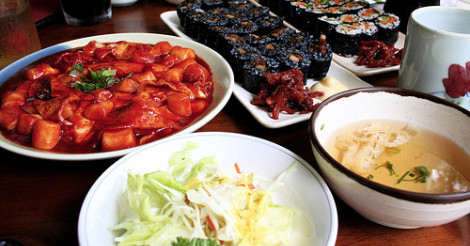
 )
)Eating well in academia can be challenging. On any given day there’s probably pizza or donuts or cookies somewhere on campus. When either your time or your money (or both) are limited—and for students and faculty alike they often are—it’s hard to beat “free” and “right here.” But even with unlimited funds to buy whatever you wish and unlimited time for shopping and preparation, eating well still poses a challenge. There is an educational component as well; you have to learn or be taught what choices to make. And as this New York Times survey illustrates, sharing that knowledge is an imperfect and incomplete process.
The survey compared nutritionists perceptions of different foods with public perceptions. Specifically, they asked both groups if a variety of foods were “healthy.” Of course, my immediate reaction is reflect on whether a binary ‘healthy’ / ‘not healthy’ is the best way to categorize food. Context matters; dose matters; ‘pizza’ is a broader category than ‘oranges.’ And the average rating of even a group of nutritionists is a scale that requires care when interpreting; orange juice isn’t necessarily twice as healthy as frozen yogurt just because twice as many nutritionists labeled it healthy. At the same time, a diet that includes more of the foods that nutritionists agree are healthy than the foods they agree are unhealthy will likely serve your body well.
Despite the story’s interest in the differences, I was encouraged by the level of agreement between nutritionists and the public. What actually surprised me more was the range of assessments from nutritionists. Even though nutrition and health questions can be investigated with science, that doesn’t eliminate all uncertainty. The benefits of fresh fruits and vegetables are pretty clear, but the story on something like butter is still being written. (The most recent study suggests modest amounts of butter are fairly health-neutral.) Meanwhile, the number of food choices keeps expanding, increasing the complexity of food decisions. In light of that uncertainty and complexity, is it reasonable to expect every individual to process all of the relevant facts and findings?
I’ll confess that even with a biology background I find it difficult to keep up-to-date with latest, most reliable findings. I believe answers to many of our nutrition questions are knowable (even if they aren’t all presently known), and I don’t want to ignore what is known. Complexity isn’t an excuse to give up, but it does require careful solutions that respect the complexity while still being simple enough to communicate and implement.
How do you navigate the complexity of food choices? What are the best ways to communicate about a complex topic to a wide audience? What are the best ways to communicate uncertainty without creating the impression that “anything goes” or overselling a tentative result?
Andy has worn many hats in his life. He knows this is a dreadfully clichéd notion, but since it is also literally true he uses it anyway. Among his current metaphorical hats: husband of one wife, father of two teenagers, reader of science fiction and science fact, enthusiast of contemporary symphonic music, and chief science officer. Previous metaphorical hats include: comp bio postdoc, molecular biology grad student, InterVarsity chapter president (that one came with a literal hat), music store clerk, house painter, and mosquito trapper. Among his more unique literal hats: British bobby, captain’s hats (of varying levels of authenticity) of several specific vessels, a deerstalker from 221B Baker St, and a railroad engineer’s cap. His monthly Science in Review is drawn from his weekly Science Corner posts — Wednesdays, 8am (Eastern) on the Emerging Scholars Network Blog. His book Faith across the Multiverse is available from Hendrickson.

Leave a Reply